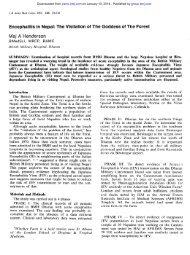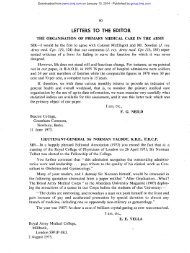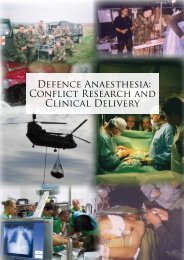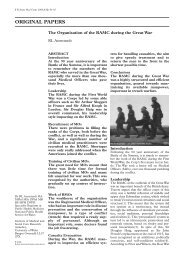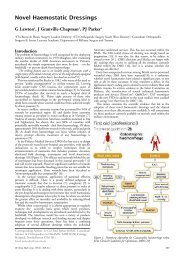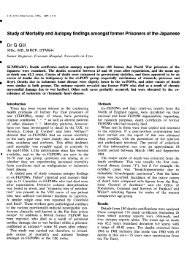I Greaves. The Pre-Hospital Emergency Care Course (PHEC): A TA ...
I Greaves. The Pre-Hospital Emergency Care Course (PHEC): A TA ...
I Greaves. The Pre-Hospital Emergency Care Course (PHEC): A TA ...
Create successful ePaper yourself
Turn your PDF publications into a flip-book with our unique Google optimized e-Paper software.
Downloaded from jramc.bmj.com on January 10, 2014 - Published by group.bmj.com<br />
J R Army M('d Corps 1997: 143: 146-148<br />
<strong>The</strong> <strong>Pre</strong>-<strong>Hospital</strong> <strong>Emergency</strong> <strong>Care</strong> <strong>Course</strong> (<strong>PHEC</strong>)<br />
A <strong>TA</strong> Initiative<br />
Maj I <strong>Greaves</strong><br />
MRCP(UK), DTM&H , DiplMC, RCSEd, RAMC (V)<br />
243 (<strong>The</strong> Wes .H~x ) Field <strong>Hospital</strong> (V), <strong>TA</strong> Centre, Ashmead Road, KeYrlsham, Bristol 8S18 lSX<br />
SUMMARY: <strong>The</strong> <strong>Pre</strong>-<strong>Hospital</strong> <strong>Emergency</strong> <strong>Care</strong> (<strong>PHEC</strong>) course is a 3 day course run by BASICS Education for the<br />
Royal College of Surgeons of Edinburgh, Royal College of Nursing and the NHS Ambulance Service. <strong>PHEC</strong> teaches<br />
and examines the care of medical, trauma, paediatric and obstetric patients in the pre.hospital em1ironment. 243 (<strong>The</strong><br />
Wessex) Field <strong>Hospital</strong> has held two of an intended ongoing programme of <strong>PHEC</strong> courses and they have proved<br />
suitable for medical and dental officers, nurses and combat medical technicians. We believe the courses to have a<br />
valuable role in the ongoing training of CMT Is as well as medical and nursing officers. Furthermore, being<br />
nationally recognised qualifications we hope the courses will have a positive effect not only on personnel retainment<br />
but on recruitment. Demand for places has far exceeded availability and we believe will continue to do so as these<br />
courses are not only highly relevant to <strong>TA</strong> service but to civilian career progression. Furthermore, as the<br />
humanitarian role of the armed forces becomes more and more important the <strong>PHEC</strong> course will become increasingly<br />
relevant to regular army personnel not only during their service but also after leaving the forces. <strong>The</strong> ultimate<br />
beneficiaries will be our patients.<br />
Introduction<br />
<strong>The</strong> Diploma of Immediate Medical <strong>Care</strong> of the Royal<br />
College of Surgeons of Edinburgh (DipIMC, RCSEd) wa,<br />
introduced in 1988 in order to encourage and assess a high<br />
standard of medical practice by doctors working in the prehospital<br />
environment. At the same time it was recognised<br />
that there were many others working outside hospital who,<br />
since they were nol registered medical practitioners, were<br />
unable to take this examination. As a consequence of this,<br />
following widespread discussions, a proposal was put to the<br />
Royal College of Surgeons of Edinburgh to estab lish a<br />
multidisciplinary course the aim of which would be to<br />
improve the care of those injured or taken seriously ill in the<br />
immediate (.;are environment It wao;; also intended that a<br />
major component of the course would be to emphasise boll1<br />
a multidisciplinary approach and the capabilities of the<br />
various emergency services involved in providing care of<br />
this kind. <strong>The</strong> fIrst <strong>PHEC</strong> <strong>Course</strong> was held in April 1993 at<br />
the National Tmining Cenlre of the Scottish Ambulam.:e<br />
Service. Since thal dale, 22 courses have been held and both<br />
the course and lhe accompanying manual have developed<br />
following comments by both students and instructors. <strong>The</strong><br />
course and manual arc now updated annually, most recently<br />
in December 1995 when, for ex.ample, a new lccturc on bum<br />
care was introduced. <strong>The</strong> course is now recognised by the<br />
British Association for Immooiate <strong>Care</strong> (BASICS), the<br />
Royal College of Nursing Accident and <strong>Emergency</strong> Nursing<br />
Association and Ihe Ambulance Service, as well as by the<br />
Royal College of Surgeons of Edinburgh.<br />
<strong>The</strong> <strong>PHEC</strong> <strong>Course</strong><br />
<strong>The</strong> <strong>PHEC</strong> <strong>Course</strong> is an intensive course taking place<br />
over three days; approximately six weeks before the course<br />
cach candidate receives a copy of the 228 page course<br />
manual and i$ expected to be reasonably famj liar with il<br />
when (he course conunences.<br />
Fig I. Advanced Airway Skill Station.
Downloaded from jramc.bmj.com on January 10, 2014 - Published by group.bmj.com<br />
<strong>Pre</strong>-<strong>Hospital</strong> <strong>Emergency</strong> <strong>Care</strong> <strong>Course</strong><br />
<strong>The</strong> course programme is as shown:<br />
DAY 1<br />
0900 Assemble<br />
0905 <strong>Course</strong> administration<br />
0910 <strong>Course</strong> Inrroduction<br />
0920 Pee-hospital care<br />
0950 <strong>The</strong> assessment of the problems faced in<br />
Pee-hospital <strong>Emergency</strong> Caee<br />
1015 Kinetics and Mechanisms of Injury<br />
1050 Coffee<br />
IllS Adult Ba.~ic Life Support<br />
1135 Adult Basic Life Support<br />
1245 Lunch<br />
(lecture)<br />
(lecture)<br />
(lecture)<br />
(skill station .~)<br />
1345 Patient Assesstllelll (lecture)<br />
1415 Airway Management in <strong>Emergency</strong> Situations (Iecturc)<br />
1435 C Spine and Head Injury Management (lecture)<br />
1515 Tea<br />
1530 Video presentation<br />
1545 Adult Airway (basic)<br />
and Patient Assessment<br />
1625 Limb stabilisation<br />
Fluid replacement<br />
1710 Video presentation<br />
1725 SkiU stations continued (see 1545 and 1625)<br />
1845 Finish<br />
1900 Supper<br />
2tOO Breathing and Ventilation<br />
2030 <strong>The</strong> Collapsed Patient<br />
2100 Trauma moulage<br />
2130 Close<br />
DAY TWO<br />
(skill stations)<br />
(lecture)<br />
(lecture)<br />
(demonstration)<br />
0815 ACLS Guidelines<br />
(lecture)<br />
0835 Cardiac Emergencies and the<br />
Immediate Management<br />
(lecture)<br />
0900 Megacode<br />
(demonstration)<br />
0915 ACLS<br />
Spinal Stabilisation<br />
(skill stations)<br />
1015 Coffee<br />
1030 ACLS<br />
Spinal Stabilisation<br />
(skill stations)<br />
1130 Video presentation<br />
1145 <strong>Emergency</strong> Management in special situations<br />
- Obstetrics (lecture)<br />
1215 <strong>Emergency</strong> Management in special situations<br />
- Paediatrics (I~cture)<br />
1300 Lunch<br />
1345 ECG R~cognition<br />
Adult airway (advanced)<br />
Patient transport<br />
(skill stations)<br />
1600 Tea<br />
1615 Shock (lecture)<br />
1645 Management of pain in pre-hospital situations (lecture)<br />
1715 Multiple casualty situations (skill stalions)<br />
1845 Finish<br />
1900 Supper<br />
1945 Optional skill stations with instructors<br />
2030 Close<br />
Fig 2. Managing a <strong>Pre</strong>·<strong>Hospital</strong> Cardiac Arrest.<br />
DAY 3<br />
0815 Extrication<br />
0835 Bums<br />
0845 Practical skills<br />
Pacdiauic Basic Life Support<br />
Should we resuscitale<br />
1100 Coffee<br />
1120 Examination<br />
1300 Lunch<br />
1345 Examination<br />
1515 Tea (with facullY meeting)<br />
1615 Results<br />
(lecture)<br />
(lecture)<br />
147<br />
(skill stations)<br />
Faculty<br />
<strong>The</strong> course is taught by a minimum faculty of eight with,<br />
in addition, an administrative assistant. This allows two<br />
instructors per skill station when four are being run<br />
simultaneously. Two extra faculty members are present on<br />
the third day to allow four pairs of examiners and two<br />
markers. <strong>The</strong> faculty is provided by BASICS Education<br />
and selected from a pool of appropriate people. Examiners<br />
are selected from course candidates who perform<br />
exceptionally well and who also have both an aptitude for<br />
teaching and experience in immediate care. Doctors with<br />
appropriate experience and teaching skills may be selected<br />
as examiners without having completed a <strong>PHEC</strong> course if<br />
they hold the Diploma in Tmmediate Medical <strong>Care</strong>. A<br />
representative of the Royal College of Surgeons of<br />
Edinburgh is customarily present on day 3.<br />
Ahhough a pool of 'military' faculty members will be<br />
acquired as courses proceed, the faculties will remain<br />
predominantly civilian in order to ensure consistency and<br />
external validity.<br />
Assessment<br />
<strong>The</strong> assessment is searching and wide ranging being<br />
composed of the following parts:<br />
written:<br />
clinical:<br />
multiple choice paper<br />
triage exercise<br />
short answcr paper<br />
slide paper<br />
trauma moulage<br />
megaeode (ACLS demonstration)
Downloaded from jramc.bmj.com on January 10, 2014 - Published by group.bmj.com<br />
148<br />
Candidates are marked using the standard Royal College<br />
of Surgeons of Edinburgh system. Any candidate with a<br />
borderline fail on either of the clinical elements may be<br />
asked to resit that component of the examination.<br />
Borderline fails in both the clinical components cannot be<br />
retaken and a clear fail in either clinical component is not<br />
remediable. All candidates are discussed by the faculty at<br />
the end of each day in order both to identify "high flyers"<br />
(and thereby potential instructors) and also, and more<br />
importantly, to identify any candidate who is struggling<br />
with all or part of the course. With the provisos given<br />
above regarding the clinical components, the overall pass<br />
mark is 60%. All candidates have a "mentor" from the<br />
faculty who is also responsible for giving them their result:<br />
the results of each section are given to each candidate<br />
individually as well as the overall result. Each candidate<br />
has an opportunity to discuss them should he wish.<br />
<strong>PHEC</strong> and the Army<br />
<strong>The</strong> first 'Army' <strong>PHEC</strong> course was held at the Duchess<br />
of Kent's Military <strong>Hospital</strong> (DKMH) Catterick in Mareh<br />
1995 for 10 CMT Is and 7 registered nurses: the pass rate<br />
was 82.34%. Shortly after this 219 Field <strong>Hospital</strong> (now<br />
243, <strong>The</strong> Wessex, Field <strong>Hospital</strong>) held its first <strong>PHEC</strong><br />
course in July 1995. lWenty four candidates took part, 4<br />
medical officers and 20 nurses (officers and other ranks).<br />
<strong>The</strong> course was held in civilian dress in order to encourage<br />
cooperation and teanl leading in all candidates irrespective<br />
of rank. Two candidates failed (pass rate 91.7%). A second<br />
<strong>PHEC</strong> course (for 243 Field <strong>Hospital</strong>) was held in January<br />
1996 for 25 candidates (3 medical officers, 1 dental officer,<br />
20 nursing officers and I CMT I). Four candidates failed<br />
(pass rate 84%), the single combat medical technician<br />
successfully completed the course. 243 (<strong>The</strong> Wessex) Field<br />
<strong>Hospital</strong> has further <strong>PHEC</strong> courses scheduled for<br />
November 1996 and November 1997.<br />
Conclusion<br />
We believe that the <strong>PHEC</strong> course is ideally suited to the<br />
I <strong>Greaves</strong><br />
Army Medical Services, both territorial and regular and<br />
hope to provide one course a year (for our unit) after our<br />
initial more intensive programme. <strong>PHEC</strong> is the only course<br />
which teaches and assesses the whole range of pre-hospital<br />
medical skills (BATLS and <strong>Pre</strong>-<strong>Hospital</strong> Trauma Life<br />
Support (PHTLS) are confined to trauma care) and yet it is<br />
suitable for medical, dental and nursing officers as well as<br />
combat medical technicians. Indeed we believe it may be<br />
particularly appropriate for CMTs as it provides a level of<br />
advanced skills and educational achievement which fits<br />
into the "vacuum" following successful attainment of<br />
CMT 1 status.<br />
As a civilian course recognised by nursing and medical<br />
professional organisations places on <strong>PHEC</strong> courses are<br />
highly sought after (approximately 3 candidates per place<br />
for our courses) and we hope will have a positive effect not<br />
only on recruitment but also on retainment. Nurses who<br />
successfully complete the <strong>PHEC</strong> course are entitled to<br />
UKCC continuing education points.<br />
<strong>The</strong>re can be no doubt that it can only be to the advantage<br />
of the <strong>TA</strong> medical services if we can provide qualifications<br />
that are not only appropriate to our military services but<br />
also valuable for career progression in civilian life. We are<br />
aware of a number of requests from employers to <strong>TA</strong><br />
members that they obtain a place on one of our courses.<br />
A considerable amount of interest in <strong>PHEC</strong> courses has<br />
also been shown by a regular personnel and we believe that<br />
<strong>PHEC</strong> is not only highly relevant to the rapidly changing<br />
role of the Anny but to its members on their return to<br />
civilian life.<br />
243 Field <strong>Hospital</strong> will by November 1996 have the<br />
largest number of <strong>PHEC</strong> trained individuals of any<br />
organisation in the United Kingdom: professionals trained<br />
and assessed in the management of prc-hospital medicine<br />
and trauma. Our present and potential patients can only<br />
benefit.<br />
T would like to thank Brigadier K Stephens late RAMC<br />
and W02 T Nuttall, Duchess of Kent's <strong>Hospital</strong> for their<br />
assistance.
Downloaded from jramc.bmj.com on January 10, 2014 - Published by group.bmj.com<br />
<strong>The</strong> <strong>Pre</strong>-<strong>Hospital</strong> <strong>Emergency</strong><br />
<strong>Care</strong> <strong>Course</strong> (<strong>PHEC</strong>) A <strong>TA</strong><br />
Initiative<br />
I <strong>Greaves</strong><br />
J R Army Med Corps 1997 143: 146-148<br />
doi: 10.1136/jramc-143-03-03<br />
Updated information and services can be found<br />
at:<br />
http://jramc.bmj.com/content/143/3/146.citation<br />
Email alerting<br />
service<br />
<strong>The</strong>se include:<br />
Receive free email alerts when new articles cite<br />
this article. Sign up in the box at the top right<br />
corner of the online article.<br />
Notes<br />
To request permissions go to:<br />
http://group.bmj.com/group/rights-licensing/permissions<br />
To order reprints go to:<br />
http://journals.bmj.com/cgi/reprintform<br />
To subscribe to BMJ go to:<br />
http://group.bmj.com/subscribe/





